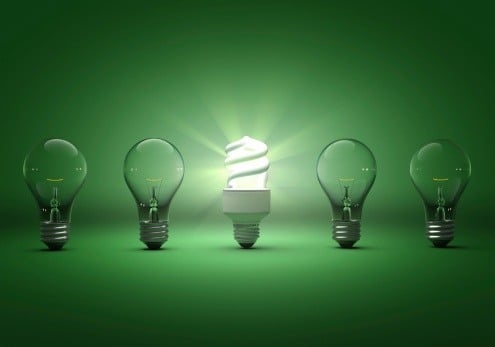 Standard incandescent light bulbs may soon become a thing of the past. We’re here to shed light on new bulbs being used. Under the Clean Energy Act, the sale of energy-inefficient incandescent bulbs was phased out over a two-year period and were no longer sold by January 2014. Compact fluorescent lights (CFLs) have become the most popular replacement choice. The typical CFL uses 66 percent less energy and lasts up to ten times longer than an incandescent bulb.
Standard incandescent light bulbs may soon become a thing of the past. We’re here to shed light on new bulbs being used. Under the Clean Energy Act, the sale of energy-inefficient incandescent bulbs was phased out over a two-year period and were no longer sold by January 2014. Compact fluorescent lights (CFLs) have become the most popular replacement choice. The typical CFL uses 66 percent less energy and lasts up to ten times longer than an incandescent bulb.
Making the Switch
Encouraging members in your homeowners association to make the switch to CFLs doesn’t require that they throw out all the incandescent bulbs right away. Even a gradual change can result in significant savings. Just replacing a home’s five most frequently used light fixtures can save more than $65 each year, as CFLs provide the most savings when a lighting source is used for at least two hours a day. Incandescent bulbs can continue to be used for fixtures that are only on for a few minutes at a time, such as closet lights, while changing to CFLs as the supply of incandescent bulbs runs out.
One important point to know about CFLs is that they contain an average of 4 milligrams of mercury (about the amount that would cover the tip of a ballpoint pen). The mercury is sealed within the bulb’s glass tubing, and no mercury is released when the bulb is intact or use. Special caution must be taken when disposing of used bulbs or cleaning up broken bulbs, however. Some states require used CFL bulbs (broken and unbroken) to be taken to local recycling centers for disposal.
If a bulb breaks encourage members of your homeowners association to follow the Environmental Protection Agency’s guidelines to clean up the debris:
Before Clean-up: Air Out the Room
- Have people and pets leave the room, and don't let anyone walk through the breakage area on their way out.
- Open a window and leave the room for 15 minutes or more.
- Shut off the central forced-air heating/air conditioning system, if you have one.
Clean-Up Steps for Hard Surfaces
- Carefully scoop up glass pieces and powder using stiff paper or cardboard and place them in a glass jar with a metal lid (such as a canning jar) or in a sealed plastic bag.
- Use sticky tape, such as duct tape, to pick up any remaining small glass fragments and powder.
- Wipe the area clean with damp paper towels or disposable wet wipes. Place towels in the glass jar or plastic bag.
- Do not use a vacuum or broom to clean up the broken bulb on hard surfaces.
Clean-up Steps for Carpeting or Rugs
- Carefully pick up glass fragments and place them in a glass jar with a metal lid (such as a canning jar) or in a sealed plastic bag.
- Use sticky tape, such as duct tape, to pick up any remaining small glass fragments and powder.
- If vacuuming is needed after all visible materials are removed, vacuum the area where the bulb was broken.
- Remove the vacuum bag (or empty and wipe the canister) and put the bag or vacuum debris in a sealed plastic bag.
Clean-up Steps for Clothing, Bedding and Other Soft Materials
- If clothing or bedding materials come in direct contact with broken glass or mercury-containing powder from inside the bulb that may stick to the fabric, the clothing or bedding should be thrown away. Do not wash such clothing or bedding because mercury fragments in the clothing may contaminate the machine and/or pollute sewage.
- You can, however, wash clothing or other materials that have been exposed to the mercury vapor from a broken CFL, such as the clothing you are wearing when you cleaned up the broken CFL, as long as that clothing has not come into direct contact with the materials from the broken bulb.
- If shoes come into direct contact with broken glass or mercury-containing powder from the bulb, wipe them off with damp paper towels or disposable wet wipes. Place the towels or wipes in a glass jar or plastic bag for disposal.
Disposal of Clean-up Materials
- Immediately place all clean-up materials outdoors in a trash container or protected area for the next normal trash pickup.
- Wash your hands after disposing of the jars or plastic bags containing clean-up materials.
- Check with your homeowners association and local or state government about disposal requirements in your specific area. Some states do not allow such trash disposal. Instead, they require that broken and unbroken mercury-containing bulbs be taken to a local recycling center.
Remember that LED bulbs are another energy saving option bulb that does not require special disposal. If you are questioning what is best for your home, visit a local store such as Lowe's or Home Depot and ask for help. They should be happy to shed light on new bulbs in the market.
Related Articles:
Resident Tips from an HOA Board: A Yard's Curb Appeal Counts
Simple Stain Removing Solutions for Homeowners Association Residents










